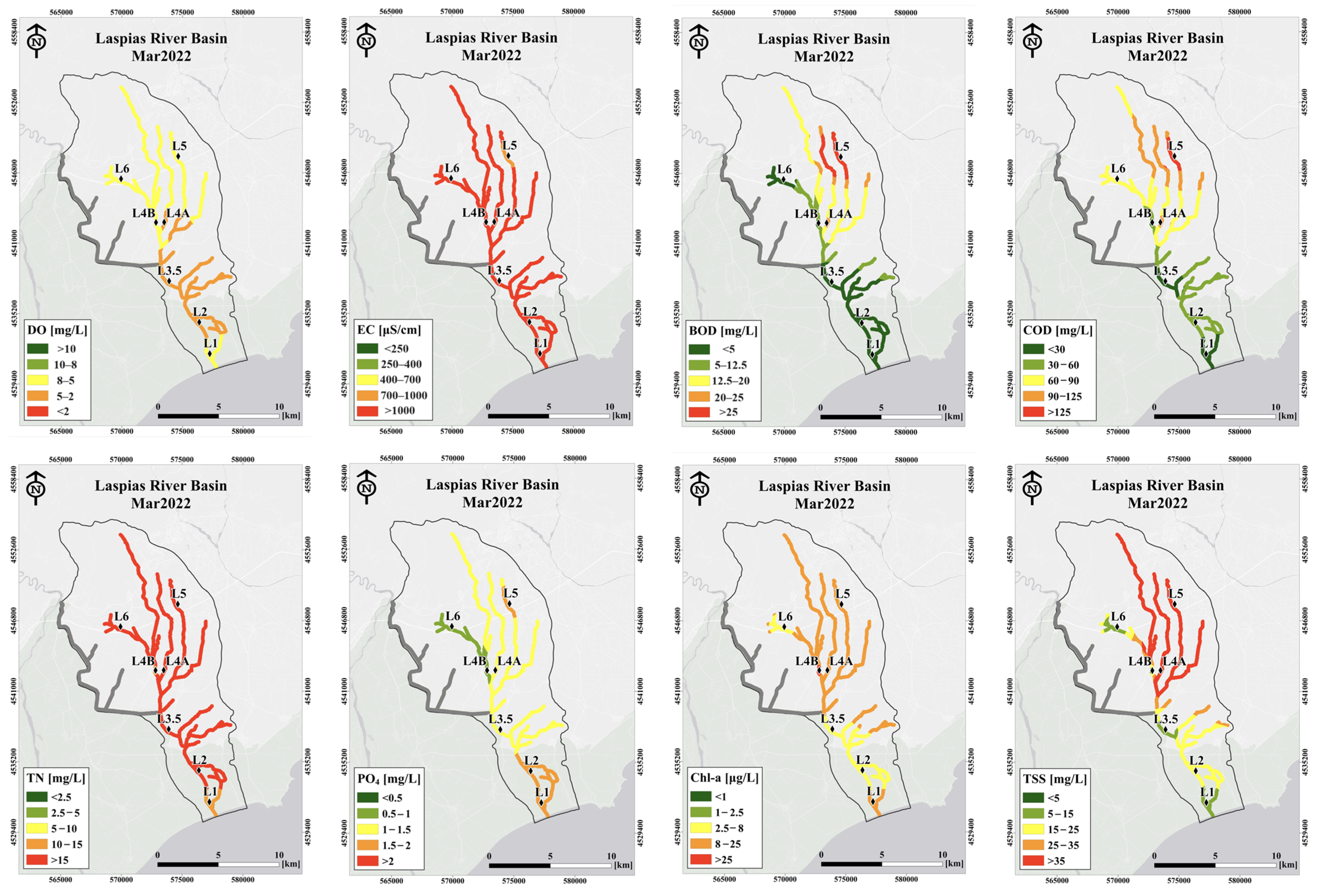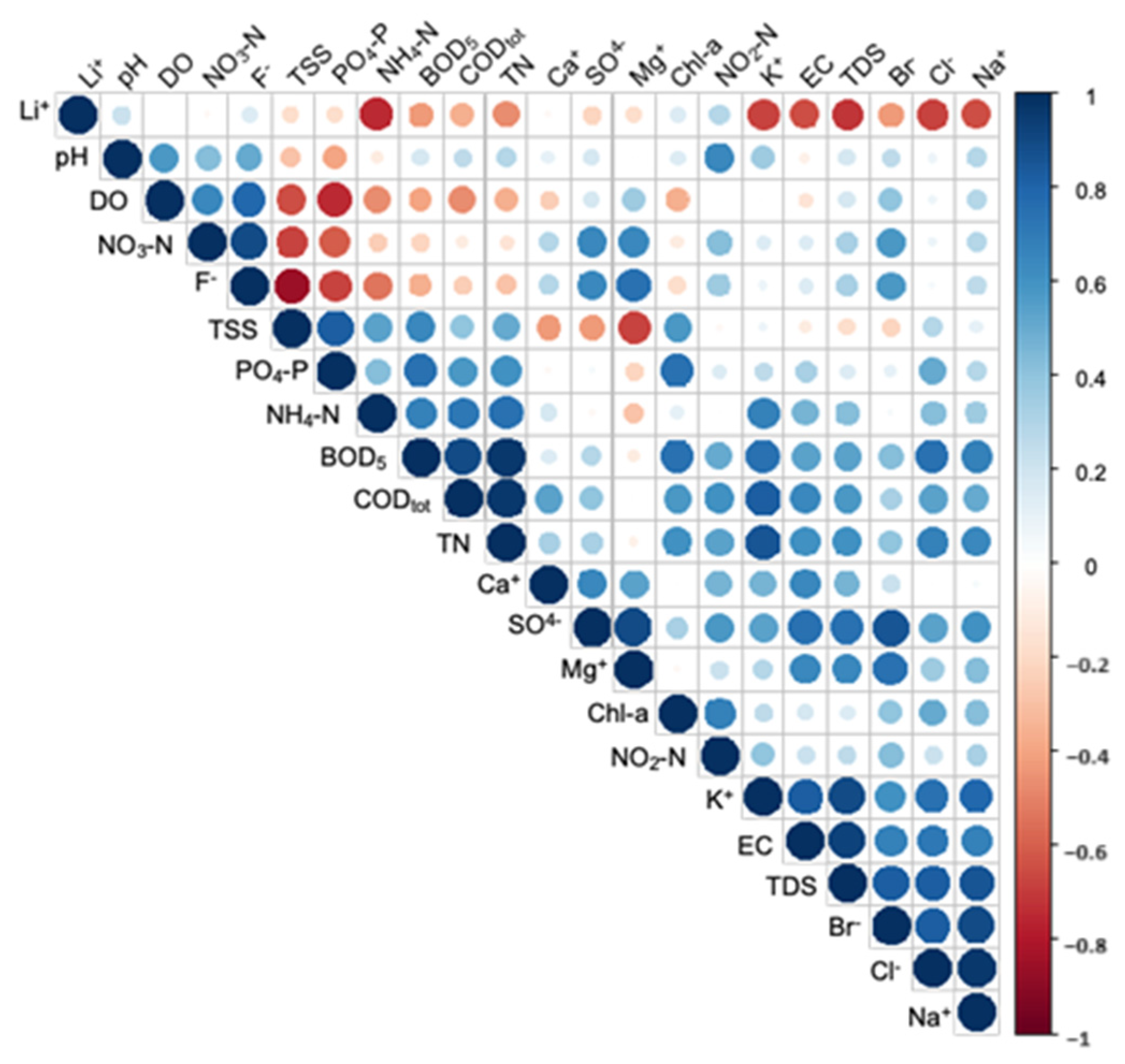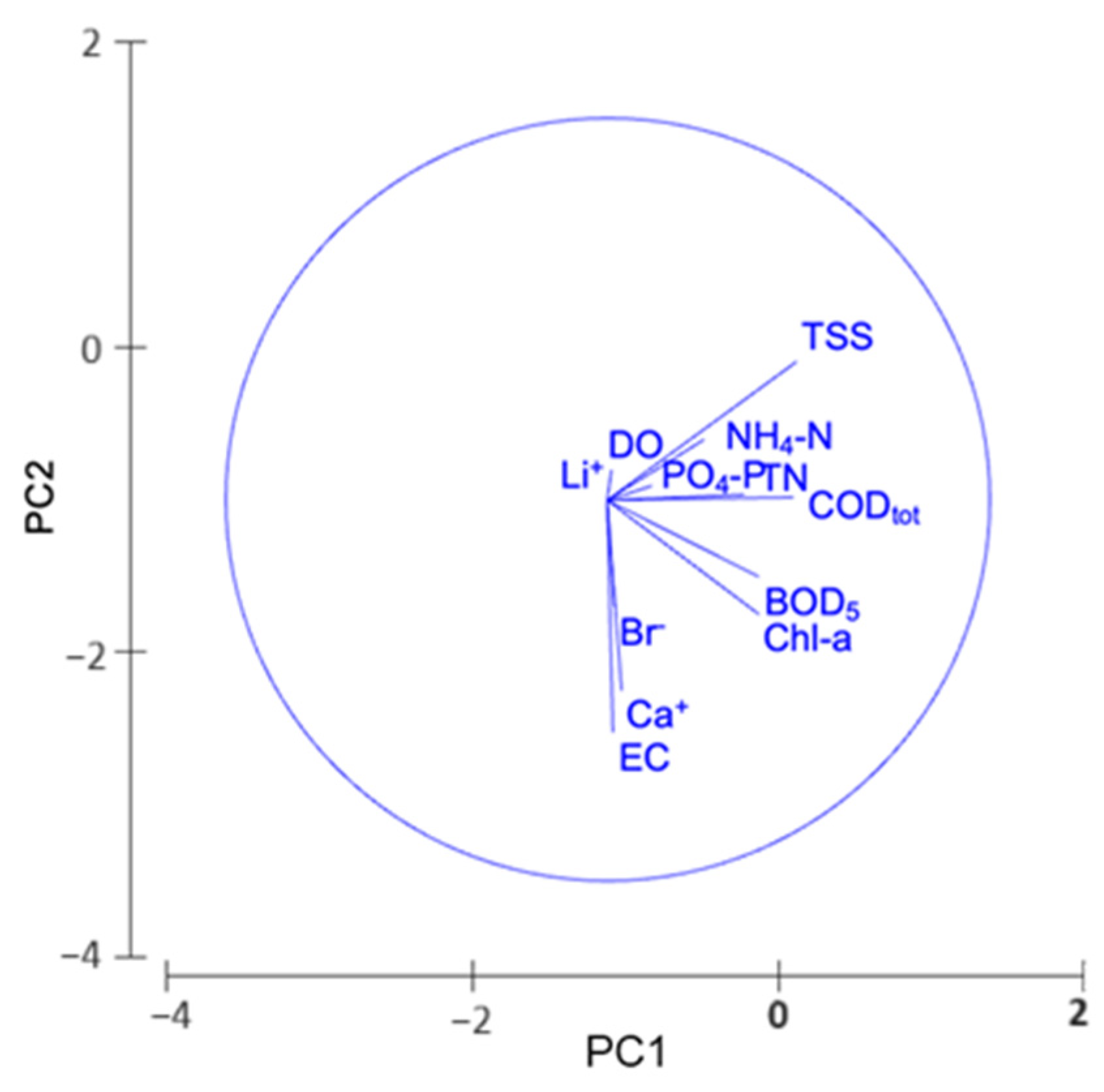1. Introduction
Surface water is the main freshwater resource of the world [
1] and is a requirement for the welfare of all forms of life and an essential condition of ecological diversity and sustainable development [
2,
3]. Rivers, as the primary source of freshwater, render an irreplaceable service for human survival and social development. Nowadays, river quality deterioration has raised significant concerns from governments and the public due to the increasing urbanization and rapid growth of the economy [
4,
5]. Studies have shown that river water quality is mainly affected by the excessive discharge of agricultural drainage [
6], as well as from industrial and urban outfalls [
1,
7]. As a result, environmental protection is rising as an important issue in public policy throughout the word, and the developing countries face a serious threat associated with the lack of appropriate integrated management of aquatic ecosystems and the challenges posed by climate change [
8].
Within the European Union (EU), the Water Framework Directive (WFD) 2000/60/EC [
9] has been the major legislative driver that regulates the protection and the achievement of good ecological status in streams and rivers [
10]. Hence, the WFD and the relevant national legislation impose the continuous monitoring of water bodies to detect pollution violations and deter the spread of associated hazards in inland, transitional, and coastal waters, as well as in groundwater [
11]. In addition, the Marine Strategy Framework Directive requires all EU member states to maintain the ecological status of coastal waters at acceptable levels and to take all appropriate measures to prevent and limit marine pollution. Monitoring the quality in both river and coastal waters constitutes a crucial aspect for evaluating their quality status over the watershed. This is particularly important due to the potential pollution of the sea from river discharges, which may result in the contamination of benthic habitats, fish, and mollusks [
12].
The imperative for monitoring river quality remains at the core of responsible environmental stewardship and sustainable water resource management [
13]. Regular observations and measurements serve as indispensable tools in assessing the health and integrity of river ecosystems. Monitoring allows for the early detection of any adverse changes in water quality, enabling swift responses to potential threats [
14]. It plays a crucial role in preservation of the well-being of both aquatic ecosystems and the communities that depend on these water sources. Furthermore, the data obtained from monitoring strategies form the basis for informed decision making, facilitating the development and implementation of effective strategies to address and mitigate environmental challenges [
10]. In essence, the necessity of monitoring river quality is paramount in ensuring the long-term viability and resilience of our water systems. Important factors in developing sustainable watershed management policies are understanding the variation in river water quality and identifying the contamination sources through collecting reliable data on watersheds [
3,
15]. To address the plurality of datasets from long-term monitoring and to easily communicate significant findings, data analyses can be of assistance since they are able to collate, summarize, and explain relevant information. Data analyses, including mathematical models and multivariate statistical analyses, are capable tools to interpret environmental data [
16,
17]. In recent years, several water quality indices (WQIs) have been used, aiming to combine water quality datasets and produce an integrated, cumulatively derived value for the level of water quality. The water quality index (WQI) and the Canadian Council of Ministers of the Environment Water Quality Index (CCME-WQI) are in widespread use for water quality evaluation, and they have received excellent assessments due to several advantages [
18,
19]. The CCME-WQI was selected for its ability to incorporate the highest possible number of parameters [
10]. Many studies assess water quality by discriminate analysis (DA), which divides a database into the best possible groups [
20,
21,
22]. In addition, in order to assess the quality of coastal water, reference thresholds should be used [
23]. The ecological status of coastal waters is usually assessed using the trophic status index (TRIX) [
24]. Consequently, all indices that preceded can play a significant role in the management of water resources for decision makers.
In the framework of the research program “Eye4water”, a series of comprehensive monitoring campaigns were carried out covering two small catchments in northern Greece (Thrace District). The project was designed as a “springs to coast eye”, focusing on assessing the water quality, identifying the sources of pollution and their impacts, and leading towards integrated water management. The decision to monitor these watersheds was based on the lack of systematic data, despite the fact that they receive runoff from various pollution sources. This work presents collected data from the two river basins derived from a two-year monitoring program. In order to provide a more precise evaluation of water quality in these rivers, the dataset was analyzed using thresholds defined by legislation and statistical models. The Water Framework Directive classification scheme was employed, followed by the Canadian Council of Ministers of the Environment Water Quality Index (CCME-WQI) and the trophic status index (TRIX) for the evaluation of coastal water quality. The findings of this study constitute fundamental prerequisites for raising awareness among citizens and stakeholders and for implementing effective governance and management practices. Given that these two watersheds have a significant ecological and economical footprint (agriculture), there is an imperative need to control environmental pollution to preserve public health (following the farm-to-fork approach) and biodiversity.
4. Discussion
The Laspias River demonstrated significant organic and nutrient pollution with signs of eutrophic and supertrophic levels. This is due to several anthropogenic activities, including agricultural and livestock runoff, inappropriate agricultural practices (overfertilization), etc. [
3,
10]. The situation was better in the Lissos River, which received less pressures in comparison to the Laspias. Specifically, in the Laspias River, it has been observed that certain sampling points register DO concentrations falling below 2 mg/L [
47], values leading to fish death in many cases. Similarly, EC values for most freshwater have ranged from 10 to 1000 μS/cm, while for polluted waters, they exceeded 1000 μS/cm [
47]. This can be attributed to high ion concentrations (such as nitrates, chlorides, sulfates, calcium, etc.) in certain parts of the Laspias watershed due to the discharge of untreated livestock waste into the river and the use of fertilizers on agricultural land [
26]. The prevalence of high organic matter concentrations was verified by measurements of COD and BOD
5. However, lower-altitude sampling points demonstrated better water quality status concerning organic matter, implying that the Laspias tributary, despite its significant pollution level, exerts minimal influence on the primary river’s water quality, possibly due to its lower flow compared to the main river. Furthermore, the high concentrations of ammonia nitrogen across all sampling points may mark organic pollution originating from domestic sewage, industrial waste, and fertilizer runoff. The levels of NO
2-N remained consistently minimal or non-existent at all monitoring stations. Nitrate compounds found in the Laspias River originate from agriculture and are also generated through the conversion of ammonia into nitrites and nitrates (nitrification). According to Chapman [
47], the typical concentration of total phosphorus (TP) in most natural surface water bodies falls within the range of 0.005 to 0.02 mg P. Exceeding this limit could be attributed to the proximity of existing livestock facilities near the sampling sites. The most common effect of increased N and P in aquatic ecosystems (i.e., rivers, lakes, reservoirs, and coastal areas) is the increase in the abundance of aquatic plants and algae. These results indicate a potential negative impact on the aquatic coastal ecosystem where the river empties.
On the other hand, the Lissos River indicated a much better chemical condition, except for station 11. Sampling station 11 was located next to a farming industry. According to Chapman [
47], it exceeded the limits for organic matter (BOD
5, COD) and nutrients (NH
4-N, NO
3-N, and PO
4-P). Additionally, increased nitrogen levels at some stations were observed near agricultural land, indicative of intense agricultural activities in the area. Finally, fluctuations in water quality at many stations may be attributed to the unstable river flow, as some points were periodically dry. The above observations agree with previous studies [
26,
48]. It is noteworthy that there is a lack of literature concerning the investigation of the two study areas, indicating an insufficient examination, despite their notable significance due to the many pressures they face, the use of their water for irrigation, and their discharge into swimming areas. An exception is the research addressing seawater intrusion into the groundwater aquifer [
49,
50,
51].
Since there are no water quality indices developed specifically for Mediterranean rivers, an initial attempt was made using the CCME-WQI [
52] for the assessment of water quality in the two watersheds, because it is one of the most popular water quality indices. Perrin et al. [
53] assessed the water quality of the Vene River (France) and the Oued Fez and Sebou rivers (Morocco) in the Mediterranean region using 17 WQIs, including the CCME-WQI. The results showed that the index was sensitive to hydrological conditions and different geographical locations. The CCME index clearly reflected changes in water quality along the rivers, even under extreme low flow conditions that characterize most ephemeral rivers in the Mediterranean region [
10]. Furthermore, Hamlat et al. [
54] provided results for the Tafna watershed (northwestern Algeria) similar to those for the Laspias River in this study, regarding the relative performance of the CCME index, emphasizing that results differ from one region to another depending on local conditions. Previous studies have demonstrated the efficacy of the CCME index in delineating spatial and temporal alterations within river water. Consequently, the integration of the CCME index stands as a valuable instrument for system administrators and policymakers.
The impact of the transfer of nutrients and organic descriptors from rivers to the downstream coastal zones has been assessed and proven [
55]. In other words, coastal waters are exposed to local runoff and aquaculture. Instances within the Mediterranean region reveal that rivers with significant environmental pressures negatively impact the quality of the seas they discharge into. Notable illustrations include the Po and Rhone rivers, discharging into the northern Adriatic Sea and the Gulf of Lion, respectively [
56]. These river basins stand amongst the most densely populated and exploited in Europe, reporting nutrient loads sourced from agriculture, as well as untreated or inadequately treated domestic and industrial wastewater. The degradation of coastal area quality may precipitate phenomena such as eutrophication and heightened algal proliferation. To prevent such phenomena and evaluate the eutrophic status of coastal zones, indices are used. In the present study, the assessment of their eutrophic status was made using two indices, TRIX and Chl-a, which are well-established in the context of Greek seas [
22,
33].
There exist numerous rivers and their reaches in Greece that are significantly degraded [
57]. One of the primary challenges for the rivers under consideration persists in the form of point source pollution. The untreated domestic wastewater from urban point pollution sources constitutes a substantial contributor, representing 20% of organic pollution and serving as the primary source of phosphorus inputs. Moreover, diffuse land use pressures contribute to 17.5% of nitrogen inputs and 40% of phosphorus inputs [
58]. Generally, there is a decline in diffuse pollution originating from agricultural sources, as evidenced by a considerable overall reduction in nitrate concentrations in the recent period. This is due to a long-term drop in fertilizer application in Greece, Bulgaria, and North Macedonia, and possibly to the application of the Nitrates Directive. The recent improvements in the quality of a number of rivers, such as the Evros, Nestos, Axios, Pinios, Acheloos, and Aoos, are positive examples related to decreased fertilizer application [
57]. Conversely, there are rivers in Greece presenting persistently elevated nutrient levels, estimated to stem from agricultural activities. For example, the Louros river has been highlighted as vulnerable for eutrophication, and published studies have classified the water quality as “fair” or “poor to fair” [
59,
60,
61], with agricultural activity identified as the primary source of pollution. On the other hand, it is apparent that in terms of BOD and nitrogen inputs, livestock breeding is the most environmentally polluting activity [
58]. Given that, predicting its environmental impact is accompanied by a degree of uncertainty. This uncertainty arises from a lack of data regarding the locations of livestock farms and associated pasture lands. Greece suffers mainly from ineffective national environmental policy planning coupled with inadequate implementation of environmental legislation. It was concluded that only 10–15% of water bodies can be identified as not at risk of failing the good status target [
62].
The European Union’s Water Framework Directive (WFD) [
9] has established objectives to prevent the deterioration of water bodies, including inland, transitional, and coastal waters. These objectives aim to achieve and maintain a good ecological status for these water bodies [
63]. The evaluation of a river’s ecological status is grounded in river basin management plans, which encompass monitoring programs that consider various parameters of water quality. The ecological status is determined based on three qualitative elements: biological, physicochemical, and hydromorphological criteria [
64,
65]. After 22 years of implementing the WFD in Europe, there is concern that the goal of achieving good or higher status in all EU waters bodies has not yet been achieved [
66], and the effectiveness of ecological assessment is being evaluated with the exploration of improvements [
67,
68]. It should be emphasized that these indices evaluate the physicochemical condition of the waters, which was the classical assessment of water quality used before the implementation of the WFD. The inclusion of ecological lines of evidence (LoE) in the assessment of water bodies is an innovation of the WFD [
68]. Consequently, for the evaluation of the ecological status of water systems, in accordance with the WFD requirements, the results obtained from the WQIs can be utilized to assess the physicochemical component, and this assessment can be supplemented by the evaluation of biological quality elements.
5. Conclusions
Within the framework of the research program entitled “Eye4water” (
https://eye4water.com, accessed on 20 February 2021), an investigation of water quality and trophic status was conducted in two relatively understudied river systems situated in northern Greece. Results revealed noticeable impacts on water quality, possibly attributable to anthropogenic activities. Specifically, the Laspias River demonstrated “poor” and “bad” water quality status for the majority of monitored parameters. The river received high organic loads, as indicated by the determined BOD
5 and COD concentrations, which were above the EU and national legislative limits. Furthermore, the Lissos River showed “good” and “excellent” water quality for most of the examined parameters, with the exception of sampling point 11, where major organic pollution was observed. Notably, in the vicinity of the deltaic zone, the intrusion of seawater was evident from the increased EC and ion concentrations. “Bad” conditions were noted for all nitrogenous compounds (nitrates, nitrites, and ammonium), as a possible consequence of the intense agricultural activity taking place in the area.
The coastal zones of the two watersheds were characterized by high nutrients content. This may be attributed to the decomposition of seaweed covering the coastal zone. The trophic status could be classified as “moderate to poor” in the Laspias coastal zone and as “bad” status in the Lissos coastal zone.
Since the water quality in these rivers is significantly influenced by runoff from urban, agricultural, and industrial activities, the imperative for a change requires interventions to preserve water quality. Thus, sustainable solutions, like constructed wetlands or vegetated buffer strips, can be implemented to treat agricultural runoff prior to its release in the aquatic ecosystems. This nature-based approach constitutes an alternative and cost-effective solution that has been widely used for water pollution originating from agricultural activities [
69,
70,
71]. Since both the Laspias and Lissos rivers are highly affected by agricultural runoff, these applications look rather promising in the field of water purification.


























